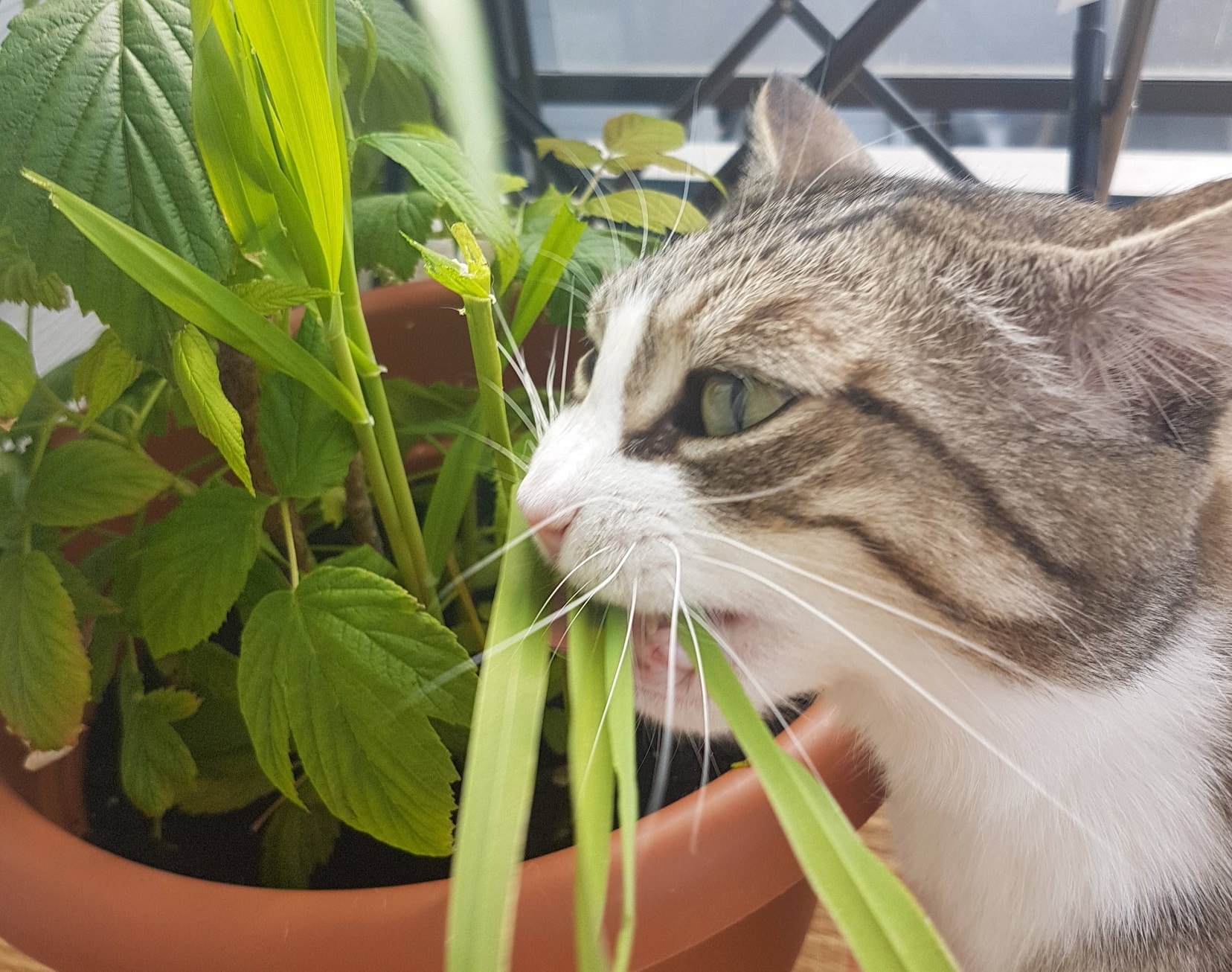Here’s How To Stop Cats From Eating Plants
Put plants on a shelf, choose unappealing species, or distract your cat by using their favorite toy as a decoy. Be sure to reward good behavior with treats, and affection. See more ways below:
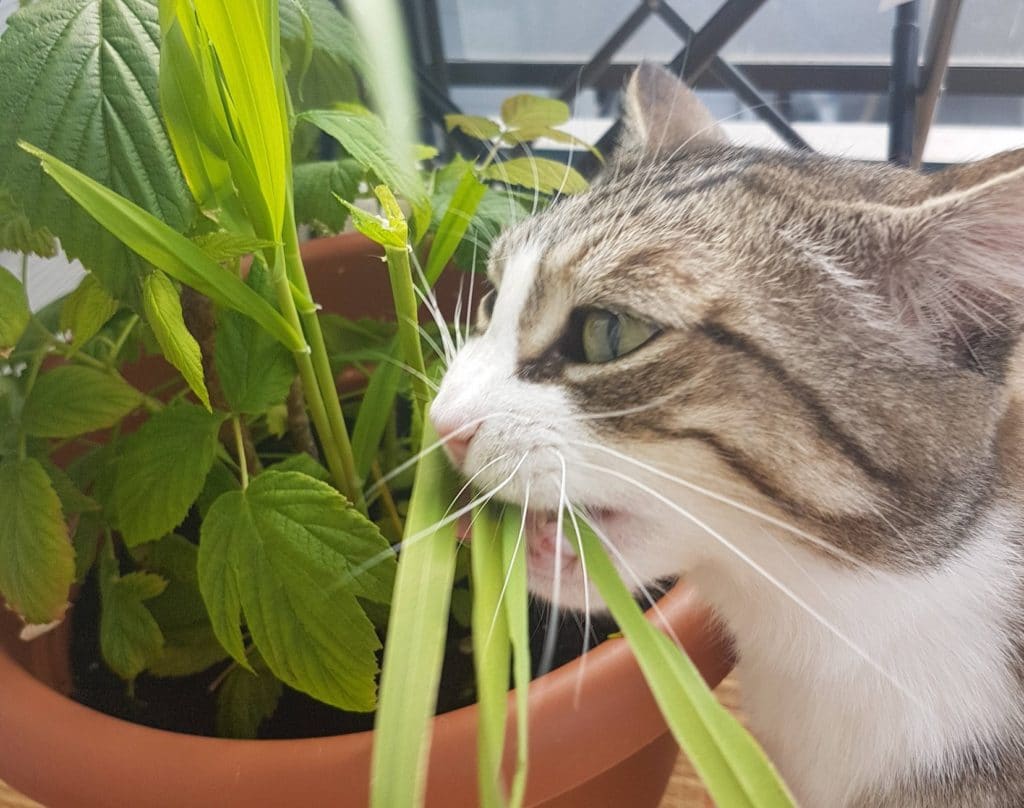
Eating plants is a common behavior for cats. They will eat plants as a way induce vomitting to eliminate hairballs, remove intestinal parasites, or even if when are bored and crave attention from you. These methods I’ve gathered here are cat-resistant, not cat-proof. You’ll want to experiment with some of these tips I’ve collected below to find out which ones work best for your unique kitty.
Here are the best ways to stop cats eating plants:
- Put plants out of reach. The most delicious plants should be placed on a high shelf to prevent your cat from nibbling the leaves.
- Choose plants that taste bad. Cats will not chew plants that taste bad and will generally leave them alone. Take note as to which ones they avoid.
- Spray Your Plants. Buy or make your own spray to deter cats from chomping on your favorite foliage.
- Have decoy plants. Certain plants can be safely used to satisfy your cats desire to nibble and will act as a decoy to distract your cat from targeting your favorites.
- Play with your cat. Whenever he chews on your plants, immediately bring out his favorite toy and start a play session. Cats mostly chew when they want your attention anyway, so give it to them!
More ways to stop cats from chewing plants:
Here are some additional methods (in no particular order) that I’ve compiled from multiple sources that you can try to help stop your kitty from chewing on your dearest plants. I haven’t personally tried all of these, so the effectiveness may vary depending on your cat:
- Enrich their environment. A stimulating environment will reduce boredom for your cat; Shelving, toys, and other pets will keep your cat busy and they will be less likely to nibble on your plants.
- Move your cat. Gently pick up your kitty when he’s chewing and put him on the floor so he knows not to continue his destructive behavior.
- Reward with treats. When your cat obeys you, give him a treat.
- Inaccessible surfaces. Fill up every square inch of a surface, your cat will not be able to gain access to your precious plants above.
- Make some noise. Effective technique, but it can scare him and lead to other anxiety induced behaviors.
- Put on Cat-TV. YouTube has some great channels designed for entertaining your kitty while you are busy.
- Offer plant clippings of cat-safe plants so they can get their plant-fix and stop chewing your plants.
- Use Feloway. Although expensive, this product can help reduce anxiety in some cats.
- Spay cat with water. This is effective but not recommended as it will cause distrust in you from your cats.
- Keep litter clean. Just like humans, cats prefer a clean bathroom area. Make sure to scoop every 1-2 days.
- Double-sided tape. On the surfaces near your plants, place strips of tape; Cats do not like stepping on sticky surfaces and will be deterred from getting too close.
- Use a clicker. A clicker is a device used for training disobedient cats with a clicking sound that signals to them that a treat is coming their way.
- Pinecones, forks, balloons, cucumbers, orange peels, and toothpicks. As crazy as it sounds, some cat owners have success placing these items around your plants as a way to keep cats from getting too close.
- Live with it. Who are we to tell them how to live their lives? In the grand scheme of things, it’s not a big deal because cats and plants are both wonderful to have and we love them for who they are.
- Introduce new plants. When bringing a new plant into your home, let the cat greet and sniff it. Cats are curious creatures as you know, letting your cat have a chance to meet your new plant will let you know if you need to keep it out of reach.
- Talk to your vet. Veterinarians may be able to provide additional insight as to why he is eating your plants. Eating plants and frequent vomiting can be a sign that your cat may be suffering from serious issues.
How to Put Your Plants out of Your Cats Reach:
There are many places your cats cannot reach. Finding out where those places are are crucial for protecting your precious plants. Here are some strategic places you can put your plants so you cat cannot reach them:
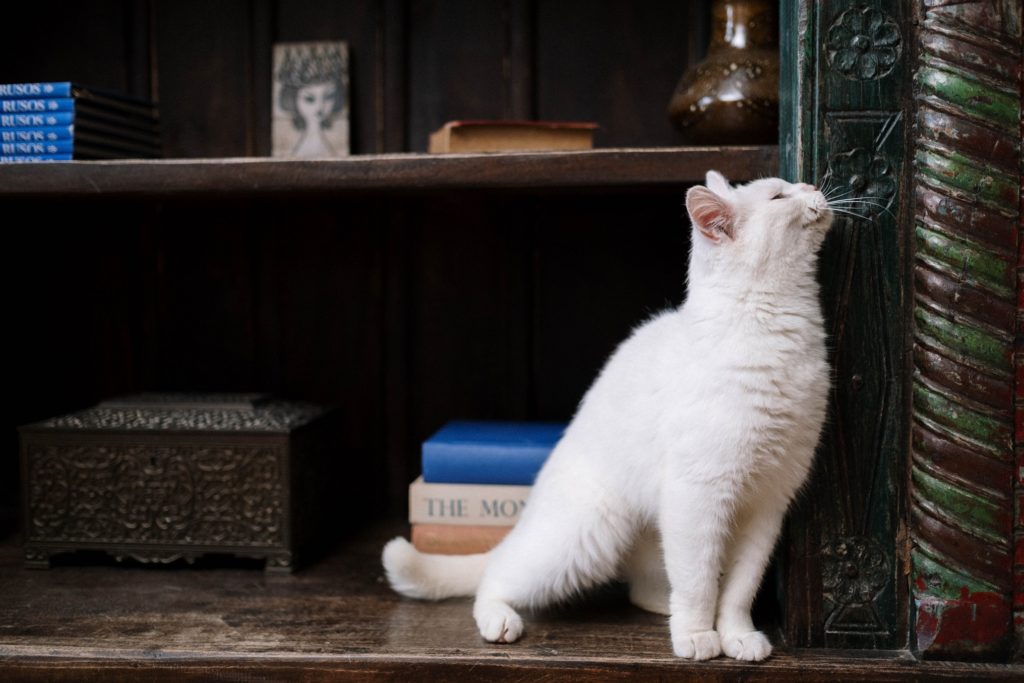
- On a bookshelf. Decorate bookshelves with plants while simultaneously preventing your cat from nibbling.
- Hang macramé. These decorative multi-tiered hangers are a smart way to keep your cats away from your favorite house plants and they also look great.
- Put them outside. If you have indoor cats, a balcony is a clever place to store your more vulnerable plants.
- Buy tall plants. Indoor trees are great because their foliage is out of reach and your cat generally wont eat the bark.
- Use a terrarium. Keeping your plants locked inside a glass or plastic container (with a lid) is a simple way to prevent your cat from gaining access to your plants.
- Plant stands. Keep your plants safely off the floor and out of reach will work for some cats.
- Buy shelving. Additional shelving is a fantastic way to increase space for plants and keep them well out of reach for your feisty felines.
- Living plant wall. An entire wall made to safely store all your tastiest plants; These can be tricky to install and maintain but add some unique decoration to your walls and can hold many plants.
Choose Plants that Taste Bad
Here is a list of plant types that cats generally dislike due to their prickly or aromatic features. Even if they are within reach, cats will tend to keep their distance.
- Cacti. Generally, cats will not mess with prickly or thorny plants like cacti or miniature rose.
- Mint. This aromatic herb smells awful to cats and taste bad too, however, this mint is toxic if eaten by cats.
- Rosemary. The smell of rosemary can be quite pungent to felines and and is safe to keep in reach.
- Citrus. Cats do not like the smell of citrus and will likely stay away from plants.
- Lavender. Cats will tend to steer clear of the strong smell given off by this plant, however it is toxic to cats.
- Coleus canina. Also known as the scaredy-cat plant, it will keep away most animals due to its terrible skunky smell. It’s so bad, you may also want to stay away from it.
Spray Your Plants (so they taste bad)
You can spray your plants so that they are unappealing to your cats. There are a number of bitter tasting store-bought sprays that are effective such as, Harbor’s Cat Repellent, or SynergyLabs Fooey, of you can even make your own spray at home. See below for instructions for making a spray at home that is safe, effective and inexpensive.
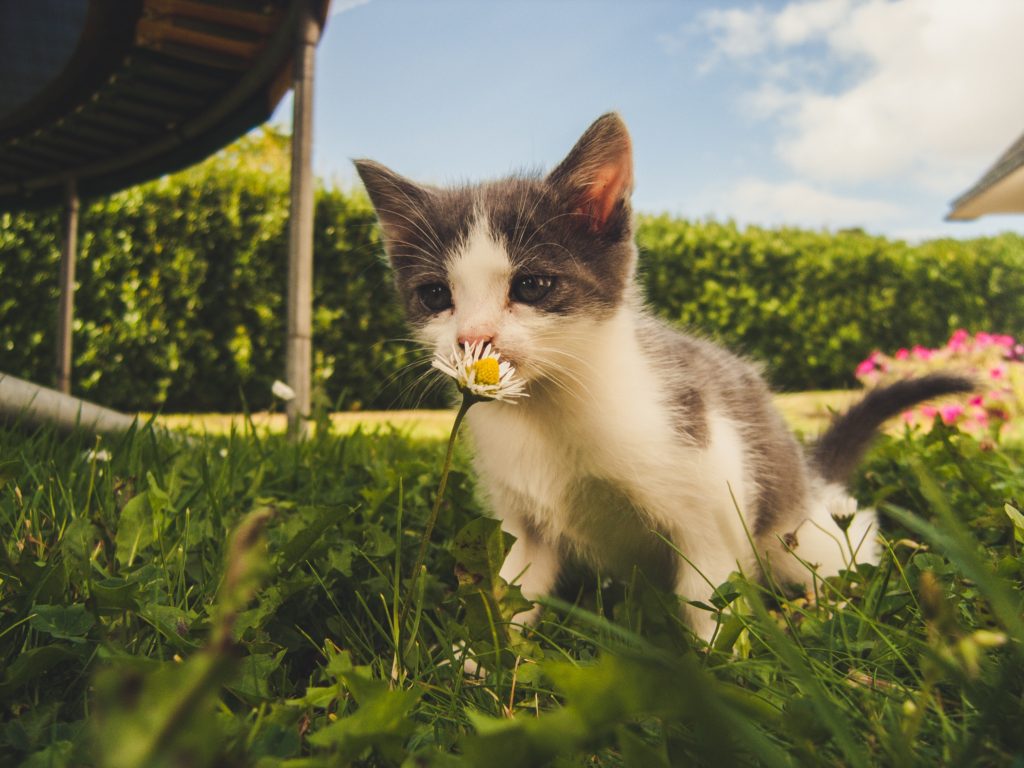
Homemade Spray to Keep Cats From Eating Plants
Fill a spray bottle with water and put in one teaspoon lemon juice, shake well, then spray the leaves and the pot with your mixture. Since every cat is unique, you may need to try a few different scents to see which works best to deter your special kitty, here are a few more you can try:
- Lime juice.
- Apple bitters.
- Chili powder.
- Orange peels.
- Eucalyptus.
- Mint.
- Essential oils.
Have Plants Especially for Your Cats to Eat
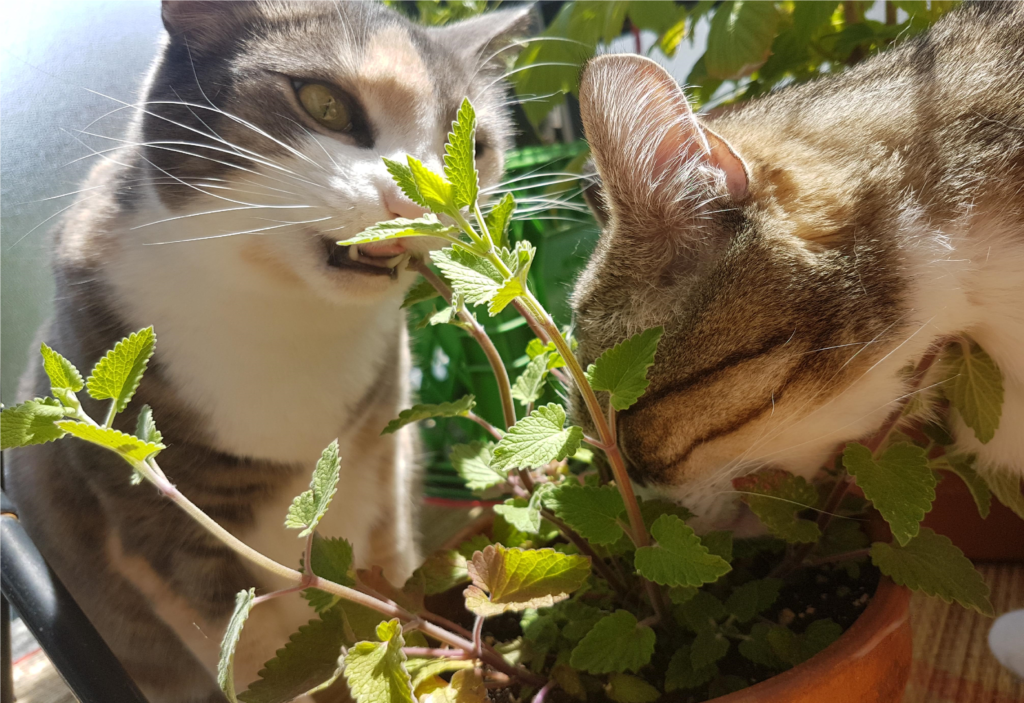
List of Common House Plants that are safe for cats:
While it is generally not a good idea to feed these plants to your cats, these plants are considered non-toxic to cats and won’t cause any lasting problems (other than an upset tummy and vomiting) for your furry friend:
- Cat-grass/Wheat grass. This is a safe plant for cats to enjoy that grows fast, easy and requires no upkeep.
- Catnip. Grow this cat-friendly plant as a way to distract from your more expensive houseplants. However, high doses can cause diarrhea, nausea, and can act as both a stimulant and sedative.
- Air Plants. Cats love to chew on the leaves of air plants and won’t cause any harm to your cat aside from a mild tummy ache if a large amount is ingested.
- Bromeliad. I’ll admit these plants look tasty, there’s no doubt your cat will agree.
- Staghorn Fern/Boston Fern. Most ferns are non-toxic to cats.
- Echeveria. This is safe for cats to consume, but it’s not behavior you should encourage.
- African Violet. Low maintenance and beautiful flowers, this houseplant is non-toxic to cats.
- Basil. Keep basil around for cooking and its lovely smell; Your cat will also appreciate it on occasion and it’s safe for them to do so.
- Christmas Cactus. I’ve never had a cat nibble my christmas cactus, but if it does, it’s considered non-toxic.
- Spider Plant. Best kept out of reach, I’ve noticed these plants are like a magnet to every cat I’ve had.
- Money Tree. The plant will not appreciate being chewed on but your cats love to chomp on money trees.
- Wax Plant. Easy to care for with brilliant flowers, this houseplant is non-toxic and adds color to any home.
- Polka Dot Plant. This tropical plant attracts both humans and cats due to its colorful and unique leaves.
- Pony Tail Palm. Though you may not enjoy this behavior, cats love to chew on the leaves of the pony tail palm and luckily, it wont cause them any harm.
- Thyme. This aromatic herb is great for cooking and also safe to keep around your hungry cat.
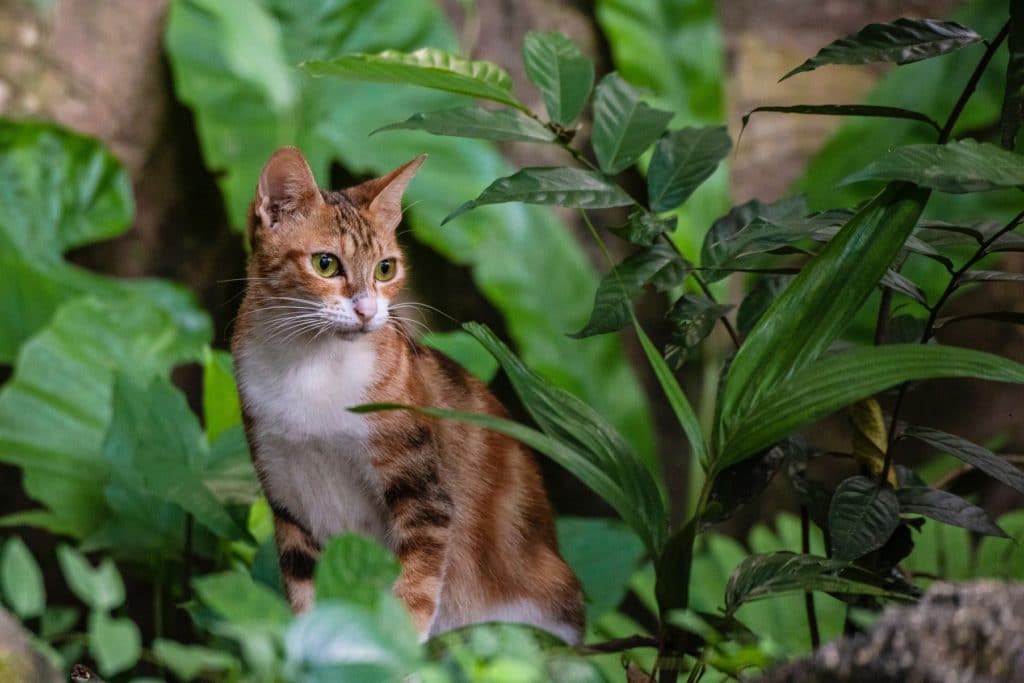
List of Common House Plants that are Toxic to Cats:
These common houseplants should not be kept where your cats can reach them as they can cause serious harm like diarrhea, vomitting, nausea and even death. For a full comprehensive list of of every houseplant known to cause toxicity it cats, please visit ASPCA.org
- English Ivy. Most ivy is toxic to cats and will cause diarrhea, vomitting and hypersalivation.
- Poinsettia. While not deadly, it will cause irritation in the mouth and stomach and best kept out of reach.
- Pothos. Signs of ingestion include, swelling in the mouth, difficulty swallowing and excessing drooling.
- Philodendron. Irritation of the mouth, including burning, excessive saliva and vomitting.
- Lavender. If eaten by your cat if can lead to nausea and vomitting or a disinterest in food.
- Carnation. You may notice mild gastrointestinal problems, or mild dermatitis.
- Snake Plant. If ingested, your cat may suffer with diarrhea, vomitting and nausea.
- Wandering Jew Plant. Can cause skin irritation (dermatitis).
- Geranium. Cats are sensitive to this plant and will show signs of depression, weakness, and even ataxia.
- Azalea. Signs that it has been ingested: Fatigue, diarrhea, and heart complications.
- Jade Plant. Can cause your cat to appear drunk, clumsy, depressed and can also lead to intense vomitting.
- Cycad. Highly toxic to cats, you may notice bloody stools, increased thirst, vomitting, and can be fatal.
- Mint. High doses can cause stomach pain, vomitting and diarrhea.
- Easter Lily. Highly toxic, ingestion can lead to kidney failure, lack of appetite, fatigue, vomitting and death.
- Peace Lily. You may notice oral irritation, swelling, vomitting, and excessing saliva production.
- Tarragon. This is only semi-toxic, you may notice diarrhea or vomitting.
- Schefflera (Umbrella Tree) – Not overly toxic, but can cause stomach irritation like vomitting and diarrhea.
- Swiss Cheese Plant. Causes intense burning in the mouth, drooling, vomitting and difficulty breathing
- Daffodil. Can cause drooling and vomitting, large doses can lead to convulsions and cardiac arrhythmia.
- Oregano. This plant can cause mild stomach irritation like vomtting or diarrhea.
- Dahlia. Can lead to mild skin problems like dermatitis.
- Parsley. High doses can lead to light sensitivity and skin irritation.
- Elephant Ear. May cause mouth irritation, oral burning sensation, vomitting and excessive drooling.
- Eucalyptus. Can cause vomtting, hypersalivation, and even depression.
- Aloe. This plant contains saponins and will cause diarrhea, vomitting and fatigue.
- Weeping Fig (Ficus). This can cause skin irritation and gastrointestinal inflammation for your cat.
What to do if your cat has eaten a toxic plant:
- Remove plant pieces. Check his teeth and gums for bits of plant and remove them immediately.
- Quarantine the plant. Put the plant out of reach or remove it from your house entirely.
- Identify the plant. Knowing which plant your cat has ingested is crucial to finding out how to save your cat if you need to bring him to the vet for urgent care.
- Check Symptoms. Look for: itching, vomitting, salivation, diarrhea, swelling, difficulty breathing
- Contact your vet. Bring a sample of the plant with you.
Play with your cat when he chews on your plants
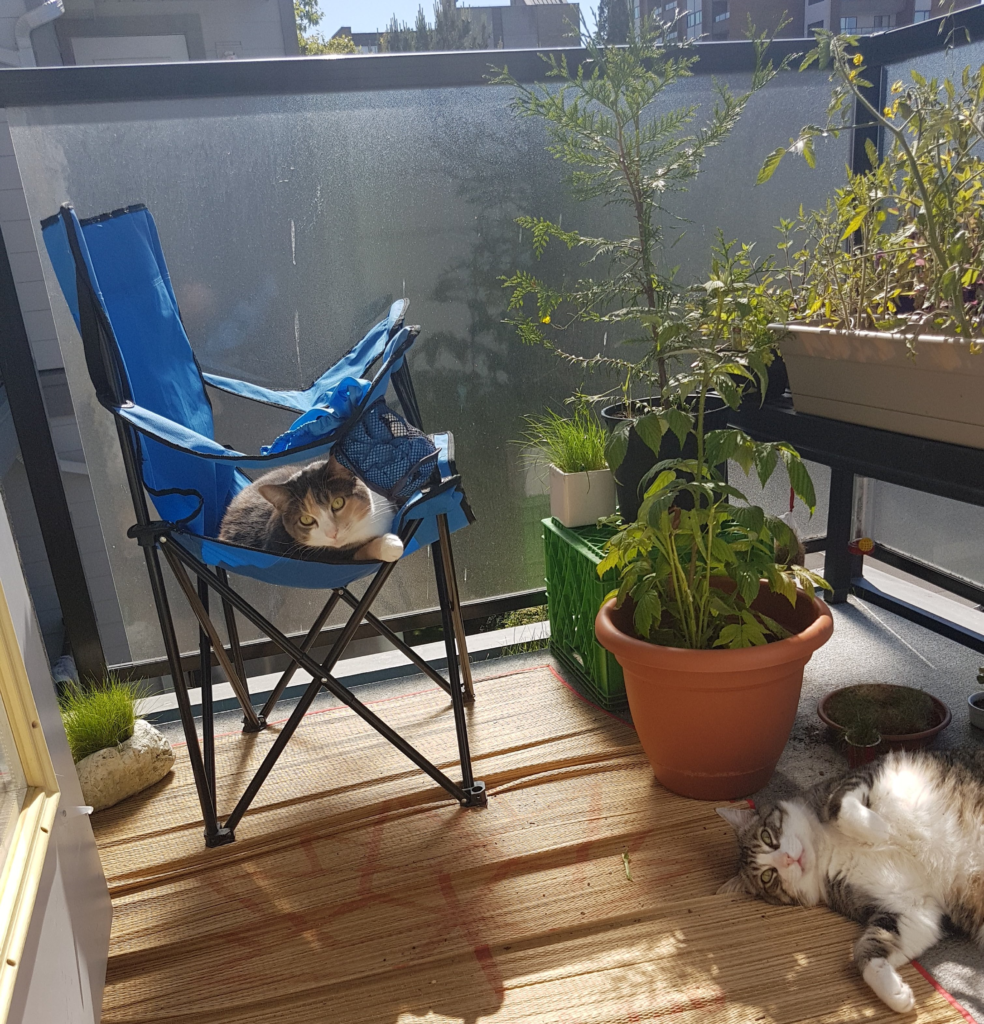
Distract your cat when he’s misbehaving around your plants:
- Play with your cat. Grab his favorite toy immediately after you notice him starting to chew.
- Distract your cat. Electronic cat toys can be effective at keeping your cat entertained if they are bored.
- Turn on CatTV. Paul Dinning Wildlife / Birder King / Cat Games / Relax My Cat / Little Paws & Family
- Get another cat. Two cats are better than one, they tend to entertain each-other while you’re busy.
- Get a fish. My cats stare for hours into my fish-tank. Make sure to keep the lid closed so the cats aren’t tempted to go fishing.
Never use these methods to stop your cat from eating your plants:
- Spraying water. Cats do not like being sprayed and while it is initially effective it could make your cat anxious and lose trust in you. Spraying may also damage your belongings that are caught in the crossfire.
- Hitting cat / Using Violence. Never use violence when disciplining your cat.
- Scaring / Loud noises. This will stress your cat and can lead to other unpleasant behavior.
- Harsh chemical sprays. This can kill your pets, your plants and yourself. Don’t risk it!
- Throwing. Your cats are smarter than they look, if they catch you throwing something at them they will remember this and act out in other ways and they will stop trusting you.
How to fix plants that have been damaged by cats:
- Put plant out of reach. Let your plant heal by keeping it away from your gnawing kitties.
- Prune damaged leaves. This is optional and does not hurt the plant to leave as is, but some light pruning can help stimulate new growth.
- Spray plant with lemon juice and water mixture to deter any future nibbling.
- Repot if necessary. If your cat has been digging or pooping in your plant you may need to give it some new soil and remove any cat feces as this does not make a good fertilizer.
Why do cats like to eat plants?
- Boredom. All cats get bored sometimes, especially housecats if they have insufficient stimulation.
- Relieve upset stomach. Cats will eat plants to induce vomitting.
- To remove hairballs. These build up over time and eating plants helps them to throw-up hairballs.
- Intestinal parasites. When cats are sick, they will eat plants as a way to vomit and remove parasites.
- Anxiety. Too much stress can cause your kitty to act out and behave in obnoxious ways.
- Crunchy texture. Cats like the texture of some plants will target the dry crunchy leaves.
- Craving your attention. Your cat needs your attention and will show you this by acting in ways that get it.

